California is a fantastic place for bird enthusiasts, especially those interested in doves. With its diverse habitats ranging from coastal areas to deserts and forests, the state hosts a wide variety of bird species. Among them, the types of doves in California are particularly interesting due to their different sizes, colors, and behaviors. Knowing how to identify these doves can greatly enhance any birdwatching experience.
In this guide, we will explore 15 common and fascinating types of doves in California. Each species has unique features and habitats that make them easy to spot once you learn what to look for. From the familiar Mourning Dove to less common visitors like the White-winged Dove, understanding these birds helps deepen appreciation for California’s rich avian diversity.
For those who enjoy watching doves in California, this article provides clear pictures and identification tips for each type. Whether hiking, visiting a park, or enjoying a backyard, you will be able to recognize these graceful birds with confidence. Let’s dive into the wonderful world of California’s doves!
Common Types of Doves Found in California
Mourning Dove (Zenaida macroura)

The Mourning Dove is one of the most common and widespread dove species across North America. It is medium-sized, with a slender body, small head, and long pointed tail edged with white. Adults are generally light brown to buffy-tan overall, with black spots on the wings and a subtle pinkish hue on the chest. Their soft, mournful cooing call gives them their name and is often heard in both urban and rural settings.
This species is easily found in a wide variety of habitats throughout California, including grasslands, open woodlands, deserts, farms, and suburban areas. They are commonly seen perched on power lines or foraging for seeds on the ground. Mourning Doves are especially abundant in the Central Valley, coastal areas, and even urban parks across the state.
Fun fact: Mourning Doves are strong fliers, capable of reaching speeds up to 55 mph (88 km/h). They can raise multiple broods each year, sometimes up to six, thanks to their fast nesting cycle and adaptability. Their wings produce a distinctive whistling sound during takeoff, which can startle predators.
Inca Dove (Columbina inca)
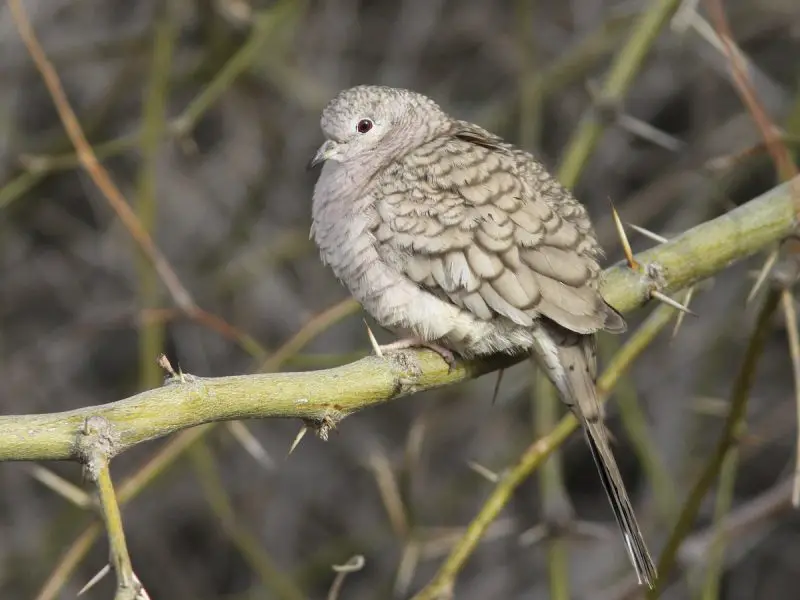
The Inca Dove is a small, delicate dove known for its intricately scaled appearance. Its feathers are light gray to pale brown with dark edging, giving a scaly effect on both the head and body. This species also has long, narrow tails that show white outer feathers in flight. It often walks with a jerky, head-bobbing motion on the ground.
In California, Inca Doves are primarily found in the southeastern regions, particularly in warm, dry urban or suburban habitats near the Mexican border. They are most often spotted in places like Imperial County or San Diego County. Although considered rare or locally common, they have expanded their range northward in recent decades, likely due to urban landscaping and warmer temperatures.
Fun fact: Inca Doves are known to roost communally in the cooler months, forming tight clusters called “dove towers” where individuals pile on top of one another for warmth. Their gentle cooing sounds resemble the phrase “no hope,” giving a surprisingly somber tone to their vocalizations.
Rock Pigeon (Columba livia)
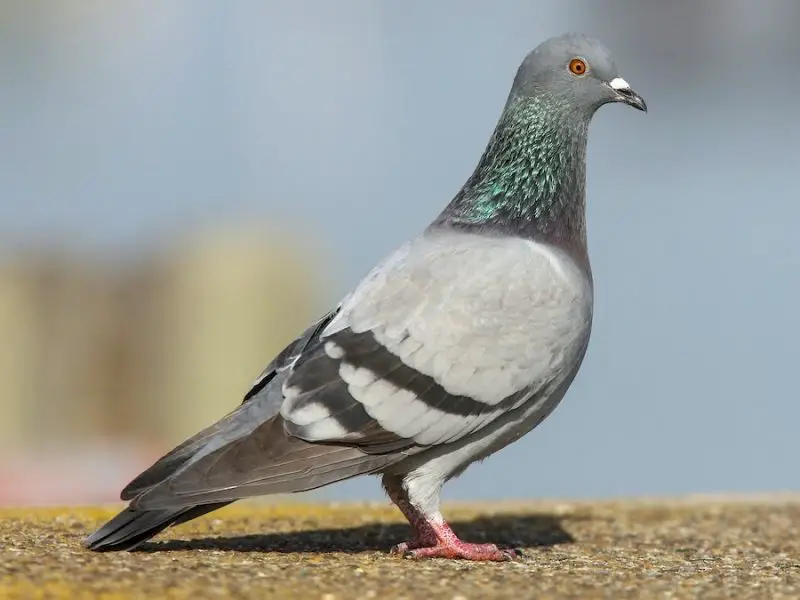
The Rock Pigeon, also known as the common pigeon, is a familiar sight in cities and towns around the world. It is robust in size with a stout body, small head, and broad wings. Most individuals are gray with iridescent green and purple neck feathers, two dark wing bars, and a black band on the tail, though coloration can vary widely due to domesticated strains.
Originally native to Europe, North Africa, and western Asia, Rock Pigeons were introduced to North America in the early 1600s and have since become firmly established. In California, they are found statewide, particularly in urban environments like San Francisco, Los Angeles, and Sacramento, where they roost on buildings, bridges, and other human structures.
Fun fact: Rock Pigeons were historically used as messenger birds due to their excellent homing ability. Some domesticated varieties have escaped into the wild and now mix with feral populations, leading to a wide variety of plumage colors not typically seen in wild doves.
Eurasian Collared-Dove (Streptopelia decaocto)
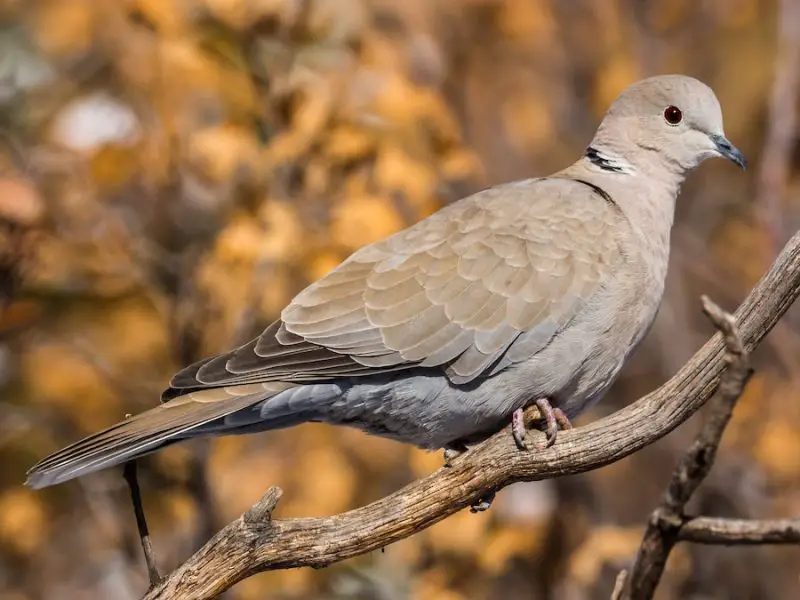
The Eurasian Collared-Dove is a pale gray, medium-sized dove recognized by the narrow black crescent or “collar” on the back of its neck. It has a squared tail with broad white tips that are especially noticeable in flight. Its cooing is deep and rhythmic, often rendered as a repeated “coo-COO-coo.”
This species is a relatively recent arrival in California, having spread rapidly across North America after escaping from captivity in the Bahamas in the 1970s. Today, it is common in suburban neighborhoods, agricultural areas, and small towns throughout California, especially in the Central Valley and southern desert regions.
Fun fact: The Eurasian Collared-Dove is an aggressive colonizer and has expanded its range faster than almost any other bird in North America. It frequently outcompetes native species like the Mourning Dove at feeders, making it a notable presence in backyard birdwatching.
Spotted Dove (Spilopelia chinensis)
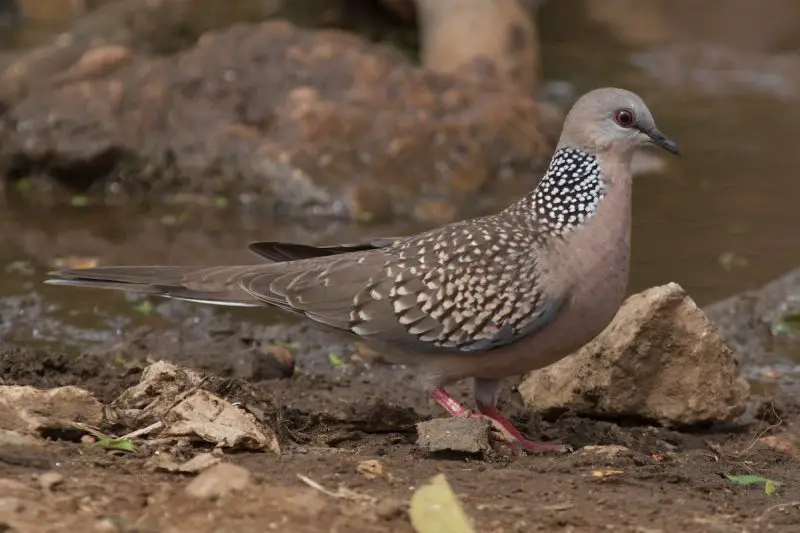
The Spotted Dove is an elegant bird with warm brown plumage and a distinctive black collar spotted with white on the nape of its neck. It has a long, graduated tail with white edges and subtle pinkish tones on its chest. Compared to other doves, it appears larger and more slender.
Spotted Doves were introduced to California from Asia in the early 20th century and became locally established, especially in Southern California. Today, their numbers have declined significantly, but they can still occasionally be found in the Los Angeles area and surrounding suburbs, favoring gardens, parks, and quiet residential zones.
Fun fact: The Spotted Dove was once common in the Los Angeles Basin but has largely been displaced by the Eurasian Collared-Dove and habitat changes. Its soft, bubbling cooing call is distinctive and often heard before the bird is seen.
Common Ground Dove (Columbina passerina)
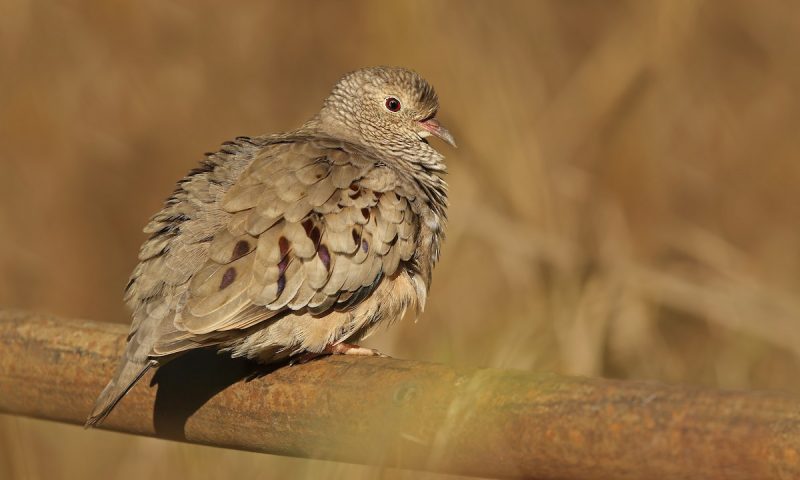
The Common Ground Dove is one of the smallest doves in North America, measuring only about 6.5 inches (17 cm) in length. It has a compact body, short tail, and a scaled appearance on its head and breast. Its plumage is mostly brownish-gray with cinnamon tones on the wings, which show rusty-red in flight.
In California, the Common Ground Dove is primarily found in the southeastern part of the state, especially in desert habitats like the Imperial Valley and parts of Riverside County. It prefers dry, scrubby areas and open woodlands with scattered shrubs, where it forages quietly on the ground for seeds.
Fun fact: The call of the Common Ground Dove is a soft, accelerating “whoop” or coo, which is surprisingly loud for such a small bird. It often goes unnoticed due to its camouflage and secretive nature, blending easily into its surroundings.
White-winged Dove (Zenaida asiatica)

The White-winged Dove is a medium-sized dove with striking white wing patches visible both at rest and in flight. Its body is a soft grayish-brown, with a distinctive blue eye ring and black streak below the cheek. When flying, it shows broad white edges on its wings and a white-tipped tail.
This species is common in the desert regions of southeastern California, especially in areas like the Coachella Valley and the lower Colorado River Valley. It is also found in urban areas where ornamental palms and fruiting trees are planted. It tends to be more common in summer, as many individuals migrate from Mexico and the Southwest to breed.
Fun fact: White-winged Doves play a crucial role in pollinating the saguaro cactus in Arizona, and while saguaros are rare in California, these doves still show strong desert adaptations. They are also one of the few doves that drink water by sucking rather than scooping, allowing for quick hydration.
Band-tailed Pigeon (Patagioenas fasciata)

The Band-tailed Pigeon is the largest pigeon native to North America, reaching lengths of about 14 inches (36 cm). It has a soft gray plumage, a distinct white crescent on the nape, a yellow bill with a dark tip, and a broad, dark tail with a pale band across it. The eye ring is often a vibrant yellow.
This species is primarily found in the forested mountain regions of California, including the Sierra Nevada, coastal ranges, and parts of the San Gabriel and San Bernardino Mountains. It prefers oak and coniferous forests and sometimes visits feeders in foothill communities, especially during fall and winter.
Fun fact: Band-tailed Pigeons are considered close relatives of the extinct Passenger Pigeon. They are strong, fast fliers and often travel in flocks to forage on acorns, berries, and seeds. Their soft, owl-like calls are often heard echoing through mountain canopies.
Ringed Turtle-Dove (Streptopelia risoria)

The Ringed Turtle-Dove is a domesticated dove, similar in appearance to the Eurasian Collared-Dove but slightly smaller and more delicately built. It has a pale, creamy-white to light tan body with a distinct black collar on the nape. Its call is a soft, repeated cooing.
This dove is not native to the wild but has been kept in captivity for centuries as a pet and for ceremonial releases. Escaped individuals are sometimes observed in California, especially in warmer residential neighborhoods and near aviaries or parks. However, they rarely form sustained wild populations.
Fun fact: Ringed Turtle-Doves have been bred in captivity to produce various color morphs and are commonly used in magic shows, weddings, and dove releases. Despite their tame nature, they retain flight instincts and may survive temporarily in the wild if conditions are suitable.
African Collared-Dove (Streptopelia roseogrisea)
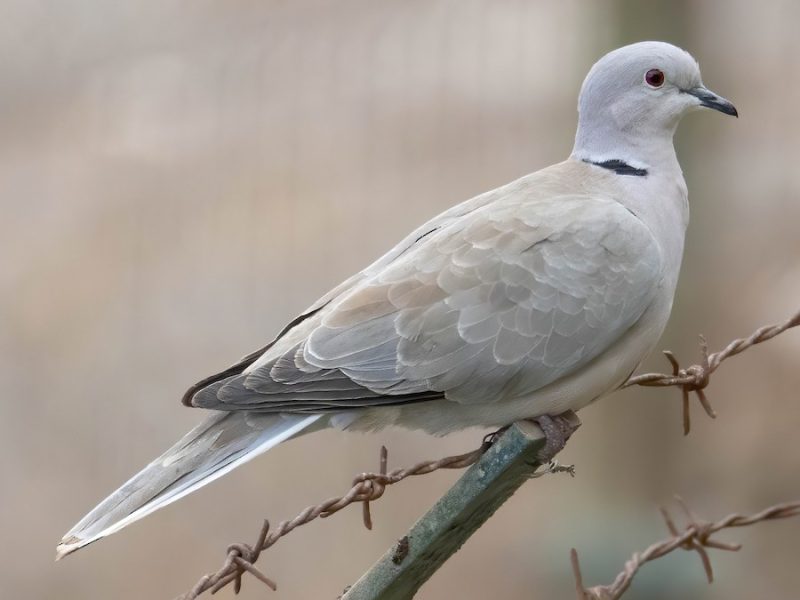
The African Collared-Dove is closely related to the domesticated Ringed Turtle-Dove and shares many physical features. It has pale pinkish-gray plumage, a black neck collar, and red eyes with a thin eye ring. Slightly larger than the Ringed Turtle-Dove, it also shows a stronger build and slightly darker tones on the wings.
In California, African Collared-Doves are rare and primarily result from escaped or released birds kept in captivity. Most sightings occur in suburban or semi-rural areas in southern and central California, particularly where people keep doves or pigeons. These birds are not considered established in the wild.
Fun fact: Because they are so similar to Ringed Turtle-Doves, identification in the field can be tricky. Birders sometimes debate over sightings of these two species, especially when observing dove flocks near urban parks. They are among the few dove species that have never formed a self-sustaining wild population in California.
Domestic Fancy Pigeons

Domestic Fancy Pigeons are a wide variety of selectively bred forms of the Rock Pigeon (Columba livia). These birds exhibit a remarkable diversity in appearance, including unique feather structures, color patterns, body shapes, and even flight styles. Breeds such as Fantails, Modenas, Tumblers, and Homing Pigeons are well-known examples.
In California, these pigeons are not wild species but frequently appear due to escapes from private breeders, hobbyists, and ceremonial releases. Cities like Los Angeles, San Francisco, and Sacramento have numerous sightings of these birds mingling with wild Rock Pigeons. They often survive well in urban environments, especially where food is abundant.
Fun fact: Some fancy pigeon breeds are unable to survive in the wild for long due to reduced flight abilities or high visibility to predators. However, others like Homing Pigeons are known for their strong orientation skills and have been used for messaging and racing for centuries.
Ruddy Ground Dove (Columbina talpacoti)

The Ruddy Ground Dove is a small, warm-colored dove native to Central and South America. Males have rich rufous-brown plumage with dark spots on the wings, while females are paler and more grayish-brown. It measures around 6.5 inches (16.5 cm) in length and has a short, squared tail.
In California, this species is considered very rare, with only a handful of sightings typically occurring in the southern part of the state near the Mexican border. These vagrant individuals are often observed by experienced birders in desert preserves or open fields during unusual migration events or irruptions.
Fun fact: The Ruddy Ground Dove has an incredibly large range in Latin America and is one of the most common doves in parts of its native habitat. Its rare appearances in the U.S. spark excitement among birdwatchers, especially in Arizona and California.
Red-billed Pigeon (Patagioenas flavirostris)
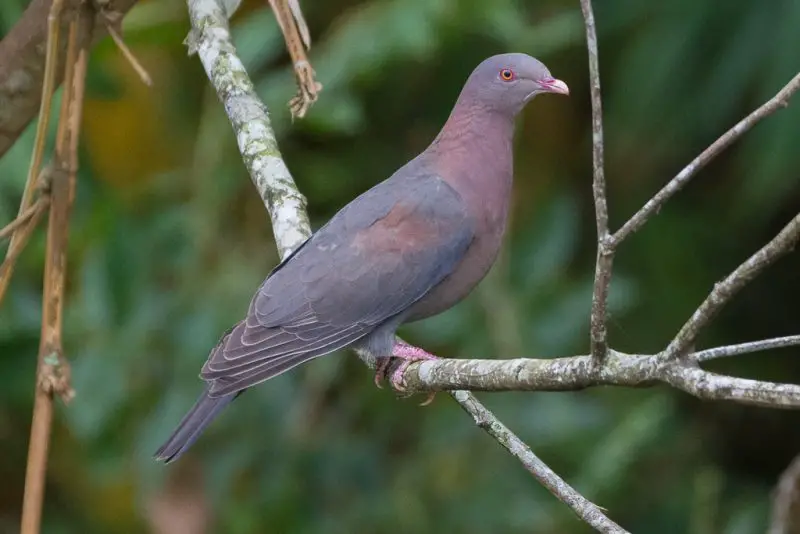
The Red-billed Pigeon is a robust, deep-purple to slate-gray pigeon with a reddish bill tipped with white and red legs. It grows up to 14 inches (35 cm) long and has a more uniform dark coloration than other pigeons. The eyes are typically reddish-orange, standing out against the dark face.
This species is primarily found in Mexico and southern Texas but is considered a rare visitor to southern California, especially near San Diego County. Sightings are very infrequent and typically involve lone birds that have strayed beyond their normal range.
Fun fact: Red-billed Pigeons are known to be shy and secretive in their native habitats, often sticking to dense river woodlands. Their rare status in California makes them a sought-after species for regional bird lists.
White-tipped Dove (Leptotila verreauxi)

The White-tipped Dove is a medium-sized, ground-dwelling dove with soft gray-brown plumage, a pale face, and distinctive white tips on its outer tail feathers, visible in flight. It also has bluish skin around the eyes and pinkish legs. It measures around 11 inches (28 cm) in length.
This species is native to Central America and the southern parts of Texas and Mexico. In California, its presence is highly uncertain and debated. A few unconfirmed or questionable reports exist from southern counties, possibly involving escaped birds or misidentified individuals.
Fun fact: White-tipped Doves are secretive and prefer forested or shrubby habitats. Their low, mournful cooing can often be heard before they’re seen. In areas where they are native, they play a key role in seed dispersal for understory plants.
Passenger Pigeon (Ectopistes migratorius)
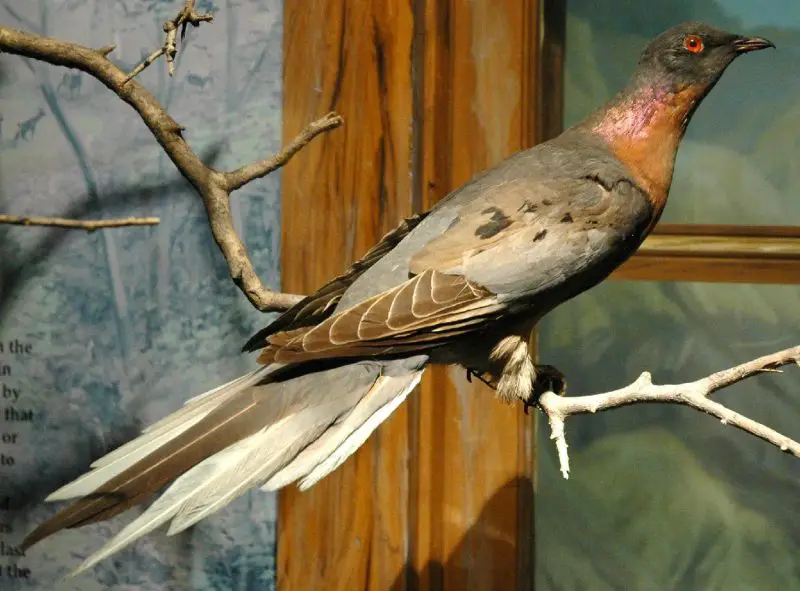
The Passenger Pigeon was once among the most numerous bird species on Earth, with flocks so vast they darkened the skies for hours. It had a slender body, long tail, and colorful plumage: males were bluish-gray above with cinnamon underparts, while females were duller in tone.
Though mainly distributed across the eastern and central United States, historical records indicate that Passenger Pigeons were occasionally seen in California during the 19th century. These sightings were likely during irregular migrations or storm-assisted movements, though the state was on the far western edge of its range.
Fun fact: The species went extinct in 1914 when the last known individual, named Martha, died in captivity at the Cincinnati Zoo. Its extinction is one of the most tragic examples of the impact of unregulated hunting and habitat destruction. Today, it serves as a cautionary symbol in conservation circles.






